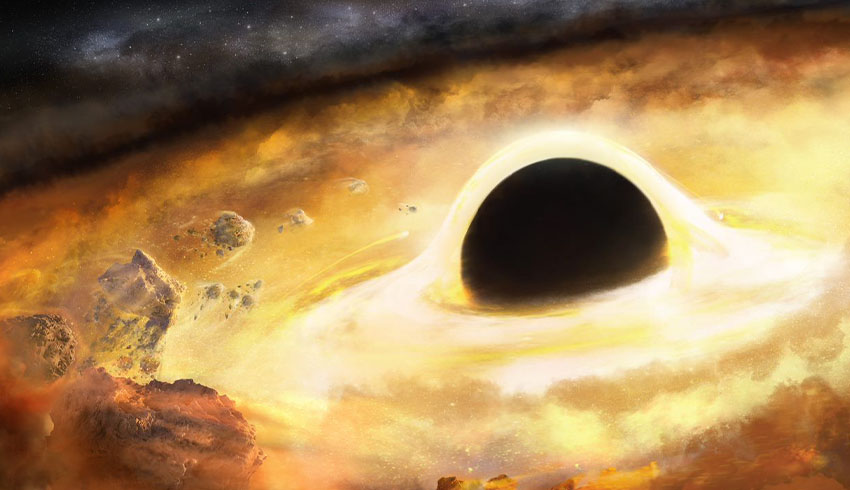The OJ 287 galaxy hosts one of the largest black holes ever found, with over 18 billion times the mass of our sun. Orbiting this behemoth is another black hole with about 150 million times the sun’s mass.
Twice every 12 years, the smaller black hole crashes through the enormous disk of gas surrounding its larger companion, creating a flash of light brighter than a trillion stars – brighter, even, than the entire Milky Way galaxy.
The light takes 3.5 billion years to reach Earth.
But the smaller black hole’s orbit is oblong, not circular, and it’s irregular: It shifts position with each loop around the bigger black hole and is tilted relative to the disk of gas.
When the smaller black hole crashes through the disk, it creates two expanding bubbles of hot gas that move away from the disk in opposite directions. And in less than 48 hours, the system appears to quadruple in brightness.
Because of the irregular orbit, the black hole collides with the disk at different times during each 12-year orbit. Sometimes the flares appear as little as one year apart; other times, as much as 10 years apart.
Attempts to model the orbit and predict when the flares would occur took decades, but in 2010, scientists created a model that could predict their occurrence to within about one to three weeks.
They demonstrated that their model was correct by predicting the appearance of a flare in December 2015 to within three weeks.
The observation of that flare almost didn’t happen. Because OJ 287 was on the opposite side of the sun from Earth, out of view of all telescopes on the ground and in Earth orbit, the black hole wouldn’t come back into view of those telescopes until early September, long after the flare had faded. But the system was within view of NASA’s Spitzer Space Telescope, which the agency retired in January 2020.
After 16 years of operations, the spacecraft’s orbit had placed it 158 million miles (254 million kilometers) from Earth, or more than 600 times the distance between Earth and the moon.
From this vantage point, Spitzer could observe the system from 31 July (the same day the flare was expected to appear) to early September, when OJ 287 would become observable to telescopes on Earth.
Seppo Laine, an associate staff scientist at Caltech/IPAC in Pasadena, California, who oversaw Spitzer’s observations of the system, said, “When I first checked the visibility of OJ 287, I was shocked to find that it became visible to Spitzer right on the day when the next flare was predicted to occur.
“It was extremely fortunate that we would be able to capture the peak of this flare with Spitzer, because no other human-made instruments were capable of achieving this feat at that specific point in time.”
Scientists regularly model the orbits of small objects in our solar system, like a comet looping around the sun, taking into account the factors that will most significantly influence their motion. For that comet, the sun’s gravity is usually the dominant force, but the gravitational pull of nearby planets can change its path, too.
Determining the motion of two enormous black holes is much more complex.
Scientists must account for factors that might not noticeably impact smaller objects – chief among them are something called gravitational waves.
Einstein’s theory of general relativity describes gravity as the warping of space by an object’s mass.
When an object moves through space, the distortions turn into waves. Einstein predicted the existence of gravitational waves in 1916, but they weren’t observed directly until 2015 by the Laser Interferometer Gravitational Wave Observatory.
Spitzer science data continues to be analysed by the science community via the Spitzer data archive located at the Infrared Science Archive housed at IPAC at Caltech in Pasadena.
JPL managed Spitzer mission operations for NASA’s Science Mission Directorate in Washington. Science operations were conducted at the Spitzer Science Center at IPAC at Caltech. Spacecraft operations were based at Lockheed Martin Space in Littleton, Colorado. Caltech manages JPL for NASA.

